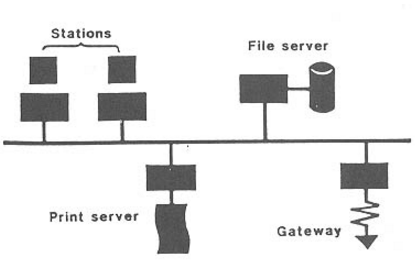Networks can be defined as a collection of independent computers and other devices interconnected by a communication medium. A network usually consists of two or more computers that are linked in order to share resources like printers and CDs, exchange files, or allow electronic communications. The computers on a network may be linked through cables, telephone lines, radio waves, satellites, or infrared light beams. There exist various types of networks, including Local Area Network (LAN), Wide Area Network (WAN), Metropolitan Area Networks (MAN), Wireless LAN (WLAN), or Wireless WAN (WWAN). Among them the LAN and WAN are the most common types. This article will give a basic introduction of LAN.
A local-area network (LAN) is a computer network that spans a relatively small area. It is a group of computers and associated devices that share a common communications line or wireless link to a server. Typically, a LAN encompasses computers and peripherals connected to a server within a small geographic area. Computers and other mobile devices can share resources such as a printer or network storage. Most often, a LAN is confined to a single room, building or group of buildings.
LANs can be distinguished from other networks because of their short distance. The total coverage may be from 1 km to 10 km. The data transmission speed of LANs is much higher than in other types of networks. Besides, the error rate in data transmission is slow because of the shorter distance between the equipment. Since LANs are within a single building or a smaller area, they are owned by the specific organization. This localized control provides greater flexibility in LANs than other types of networks.
Each workstation of the LAN can be a microcomputer, but they are connected to a central controlling unit, through which they can exchange data, share software or hardware with other workstations of the network. Though each workstation can act independently, they are not capable of controlling the activities of other stations of the network. Then, let’s just take a look at the basic components of a LAN which are shown in the following picture.

- Communication medium: there is some kind of medium to connect all the workstations and other equipment together.
- File server: a computer dedicated to providing shared access to a main storage device.
- Print server: a computer dedicated to providing shared printing facilities.
- Gateway: a computer providing access to other networks.
- Workstation: a user’s computer or any other equipment.
Based on their topology and communication media, LAN can be divided into two categories. And according to topology, LAN can take several forms but three of them can be identified as core forms. The picture below shows these three main types of LAN.

Bus—A main channel to which nodes or secondary channels are connected in a branching structure. A transmission from any computer can be received by any other computer like in the ring type. Hence there is no sufficient data security in these types.
Ring—In which each computer is connected to two neighbouring computers to form a closed circuit. Data has to pass some other computers to reach its destination.
Star—In which each computer is linked directly to a central computer and only indirectly to one another. Communication between two computers has to be done through this central controller. A particular station which wants to communicate with another station builds up a connection, through the central controlling center, with the destination. Once this connection is established data can be communicated from one to the other station.
LAN is most often adopted for the purpose of sharing resources. Thus expensive hardware like laser printers and CD/ROM drives can be shared by several users when they are connected to a network. Further, purchasing a network version of software cuts the costs of purchasing them for each and every computer.
In addition, central control of equipment and data makes administration much more easier. When it comes to the need of changing the system, better data security and more flexibility are surely guaranteed. And instead of purchasing a multi-user system, the available equipment from different vendors can be connected together using a network.
Featured by its private ownership, high speed and low error rate, LANs have gained more attention as well as popularity in the field of networking. Housekeeping applications, educational services, resource sharing, and office administration are the major area in which LANs can be applied. Hope what we presented above can help you get a better understanding of LAN.




